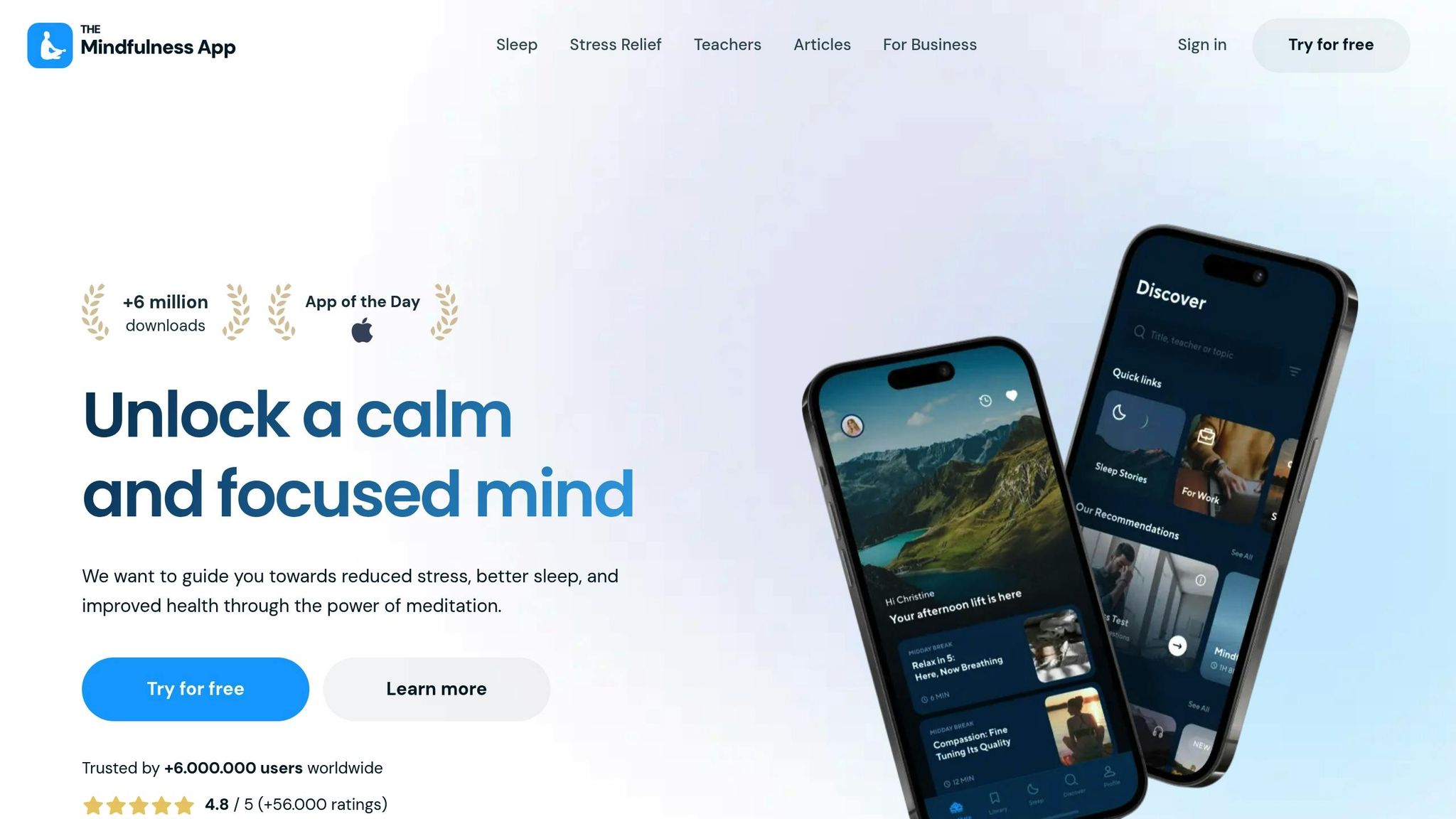Stress is a part of daily life, but managing it effectively can improve your health, focus, and overall well-being. This guide covers practical techniques like mindfulness, breathing exercises, and body scans to help you reduce stress. Here's what you need to know:
- Stress impacts your health: Chronic stress affects sleep, digestion, and heart health. For example, 66% of U.S. workers lose sleep due to stress.
- Mindfulness works: Regular mindfulness practice can reduce stress, anxiety, and depression. It helps you stay present and respond calmly to challenges.
- Simple techniques: Deep breathing, body scans, and visualization are easy ways to relieve stress anytime, anywhere.
- Build habits: Start small, like 2–3 minutes of mindfulness daily, and gradually increase. Use reminders to stay consistent.
Mindfulness tools, like The Mindfulness App, offer guided meditations and stress-relief exercises to help you stay on track. Whether you're stressed about work, finances, or daily pressures, these strategies can help you feel calmer and more in control.
3 MINUTE MINDFULNESS Exercise | (2022) Stress and Anxiety Release
Basic Mindfulness Techniques for Stress Relief
Looking to ease stress in the moment? Here are three straightforward mindfulness techniques you can use anytime, anywhere. Pick the one that feels right for your situation.
Deep Breathing and Breath Focus
Your breath is a powerful stress-relief tool. When you're stressed, your breathing often becomes quick and shallow, which can actually make you feel more anxious. Deep breathing, on the other hand, activates your parasympathetic nervous system, helping to naturally slow your heart rate and lower blood pressure.
To try this, find a comfortable spot - whether that's a chair, your couch, or even a quiet place at work. Place one hand on your chest and the other on your abdomen to feel your breath. Inhale deeply through your nose for a count of four, then exhale slowly through your mouth for a count of eight. Focus on making your exhale longer than your inhale, and let your belly rise and fall gently. Keep your breathing smooth and unforced.
Studies suggest that just five minutes of deep, slow breathing can help reduce both heart rate and blood pressure.
Body Scan Meditation
Stress can hide in your body - tight shoulders, a clenched jaw, or a stiff neck are common signs. Body scan meditation helps you tune into these sensations, bringing awareness to areas of tension without trying to change them.
To begin, sit or lie down in a comfortable position and take a few deep breaths. Start by focusing on your feet, noticing any sensations like warmth, tightness, or coolness. Gradually move your attention up through your legs, torso, arms, and finally your head, pausing briefly at each area. If you notice tension, breathe into those spots and imagine the stress dissolving with each exhale.
Research has shown that participants in body scan meditation programs experience lower levels of cortisol, the hormone linked to stress.
Guided Imagery and Visualization
When stress feels overwhelming, guided imagery can mentally transport you to a calm, peaceful place. By imagining a soothing environment, you can shift your focus away from stressors and activate your body's relaxation response.
Here’s how to try it: Close your eyes and picture a place where you feel completely relaxed. It could be a beach, a forest, or even a cozy room. Take in the details - what do you see, hear, or smell? Spend a few minutes immersing yourself in this mental escape, letting its calming atmosphere wash over you.
This technique is flexible - you can practice it during a break, on your commute, or before bed. Even if you can’t physically get away from a stressful situation, a few moments of visualization can provide a sense of relief.
These mindfulness practices are quick, simple, and don’t require any special tools. With regular use, just a few minutes of deep breathing, body scanning, or visualization can help you break free from stress and approach your day with a sense of calm and focus.
Building a Daily Mindfulness Habit
Techniques only work when practiced regularly. Research suggests it takes about 66 days for a habit to become automatic, though the benefits of mindfulness often show up much sooner.
Setting Up a Quiet Space at Home
You don’t need a big budget or a fancy setup to create a mindfulness space. A small corner of your bedroom or living room can work perfectly. The goal is to have a spot that naturally encourages relaxation.
Pick a location that’s free from distractions - away from the TV, work desk, or areas where people frequently walk through. A simple chair, cushion, or yoga mat is all you need. Keep the space uncluttered, as too much visual noise can make it harder to focus.
Adding a few calming elements can make the space feel more inviting. Maybe it’s a plant, a cozy blanket, or natural light from a nearby window. It doesn’t have to be picture-perfect - what matters is that it feels peaceful to you.
Using the same spot consistently helps your brain associate it with relaxation. Over time, this makes it easier to slip into a mindful state whenever you’re there.
Adding Mindfulness to Daily Activities
Mindfulness can fit seamlessly into your daily routine. Did you know that we spend nearly 47% of our waking hours thinking about things other than what we’re actually doing? That’s a lot of missed opportunities to be present.
Mindful eating is a great place to start. Instead of scrolling through your phone or watching TV during meals, focus on your food. Notice the colors, textures, and flavors. Chew slowly and pay attention to how each bite feels. This practice can lower stress, improve digestion, and even help you feel more satisfied with smaller portions.
Your commute is another chance to practice mindfulness. Whether you’re driving, using public transit, or walking, try being fully present. If you’re driving, feel your hands on the wheel and observe your surroundings without judgment. On public transit, focus on your breath or silently wish well to the people around you. Research shows that practicing mindfulness during a commute can reduce stress by 30%.
By weaving mindfulness into everyday tasks - like eating or commuting - you can reduce stress and feel more grounded. The key is to fully engage your senses and focus on what you’re doing, instead of letting your mind wander to your to-do list or tomorrow’s plans.
Starting Small and Building Consistency
When you’re starting out, it’s better to keep things simple. Instead of jumping into long meditation sessions, begin with quick mindfulness breaks that take just a minute or two.
For example, try taking three deep breaths before opening your email in the morning or spend 30 seconds focusing on your breath before a meeting. These small moments can make a big difference over time, helping your brain form the pathways that make mindfulness feel more natural.
“Mindfulness is not about perfection - it’s about progress. Whether you’re taking a few mindful breaths before a meeting or dedicating 10 minutes to a guided meditation, every step counts. Start small, be consistent, and notice how even the busiest professionals can find moments of calm in your day.” - Inner Clarity
Set yourself up for success by using reminders. Sticky notes on your mirror, phone alarms, or calendar notifications can nudge you to take those brief mindfulness breaks.
Don’t worry if you miss a day or two - research shows that occasional lapses won’t derail your progress, as long as you keep coming back to your practice. Focus on building the habit first, and as it becomes more natural, you can gradually increase the time you spend on mindfulness.
sbb-itb-bea8dce
How The Mindfulness App Helps with Stress

Mindfulness can be a powerful tool for managing stress, and having the right resources makes all the difference. The Mindfulness App is designed to reduce stress, improve sleep, and promote overall well-being through guided meditations and mindfulness exercises.
Features for Stress Relief
This app offers a variety of resources, including over 500 meditations, sleep stories, and courses available in 12 languages. It also includes stress tests, guided meditations, breathwork exercises, "at work" break sessions, and mindful reminders to help users take calming pauses during busy days.
Key features include:
- Stress tests to track progress
- Guided meditations for stress relief
- Quick breathwork exercises and body scans
- Curated break sessions for work environments
- Gentle reminders to stay mindful during hectic moments
According to user feedback, 89% of individuals reported feeling noticeably calmer and experiencing reduced stress levels after just one week of daily 5-minute sessions. With over 5 million downloads and an impressive 4.8/5 star rating from 7,200 reviews on the App Store, the app is frequently praised for its user-friendly design and effectiveness.
"Absolutely recommended for those who need relaxation from stress and everyday tasks. Calm down and go deep, lower your heart rate and relax your mind." - Jon B.
"During a stressful time, I can gather and feel calm in a voice that is there to help." - Anna F.
The app also goes a step further by allowing users to personalize their mindfulness experience.
Custom Meditation Programs
The Mindfulness App offers customizable meditation sessions ranging from 3 to 99 minutes, catering to individual stress-relief needs. Whether you're a beginner or seasoned practitioner, the app provides options for silent or guided meditations, adjustable durations, and background sounds. Expert-led courses address different moods and schedules, ensuring there's something for everyone. Beginners can benefit from structured programs that gradually build mindfulness skills, while personalized reminders help establish a consistent practice.
For added convenience, the app integrates with Apple Health and supports Apple Watch, making it easy to monitor your progress.
Getting Started with The Mindfulness App
Starting your mindfulness journey is simple. The app offers a free seven-day trial with full access. A great starting point is the 5-Day Introduction to Mindfulness program, which teaches the basics and helps build confidence. Afterward, you can explore the full library and tailor the experience to your needs. Premium access costs $79.99 per year (less than $7 per month) and provides unlimited access to updated content for stress management. With customizable notifications, setting reminders is effortless, helping you maintain a steady meditation routine.
Common Problems and How to Fix Them
Mindfulness provides practical ways to tackle common meditation challenges and better manage stress. Starting a mindfulness routine can feel daunting, and many people face similar hurdles along the way. Recognizing these issues and applying specific strategies can help you stick with your stress management goals.
Trouble Focusing During Meditation
Struggling to focus during meditation? You’re not alone. It’s normal for your mind to wander - it’s just how the brain works. Meditation isn’t about achieving flawless focus right away; it’s about building the habit of gently bringing your attention back.
Bhante Sathi, a meditation teacher, explains it perfectly:
"The goal of meditation is NOT to sit down and instantly have mental focus … it is to create a new habit of pulling your focus BACK … and rather than being dismayed when your mind wanders (it will wander 99% of the time at first), be pleased that you NOTICED this and brought it back - no matter how temporarily."
- Bhante Sathi
Start small. Try meditating for just 1 to 5 minutes and gradually increase the time as it feels comfortable. Use your breath as an anchor - pay attention to the rise and fall of your chest or the sensation of air moving through your nostrils. If your mind drifts, gently guide it back without frustration or judgment. Techniques like counting your breaths or silently repeating a word like "calm" can help keep your focus steady.
Pick a quiet spot with minimal distractions, sit in a comfortable position, and consider adding soft background sounds, like gentle rain, to block out noise. Many find that meditating in the early morning, when the mind is less cluttered, sets a positive tone for the day.
As you work on improving focus, you might also encounter feelings of impatience - a common hurdle in meditation.
Feeling Impatient About Results
Impatience is a natural part of learning something new. Meditation, like learning to play an instrument or ride a bike, takes time and practice. Instead of expecting instant calm, try to accept your experience as it is, without judgment.
Sometimes, meditation brings up restless thoughts or negative emotions. This is actually a sign that your practice is working - it’s helping you confront feelings you might usually suppress. As Paul Vitols, a meditation instructor, explains:
"Meditation gradually brings us ever more in touch with our experience as it actually is. It trains us to notice what is going on, and to be present with it, whatever its quality, whatever its texture - including pain, frustration, and disappointment. One of the effects of meditation is that it makes it 'safe' for negative feelings to come out: thoughts or feelings that we have habitually avoided or suppressed arise fully into consciousness where we can see them and feel them. This can be uncomfortable and alarming, but it's actually a sign that the practice is working. You have opened the door to reality, and reality is coming in."
- Paul Vitols
Be kind to yourself as you work through these feelings. Recognize that impatience is simply part of the process and a reflection of growing self-awareness. When frustration arises, return your focus to your breath, and remind yourself that progress takes time.
When to Get Professional Help
If mindfulness challenges linger or stress feels overwhelming, reaching out for professional help can make a difference. While mindfulness is an effective tool for managing everyday stress, there are times when additional support is necessary.
Consider seeking help if stress disrupts your daily life, lasts longer than two weeks, or leads you to unhealthy coping mechanisms like alcohol or drugs. Warning signs to watch for include thoughts of self-harm or suicide, withdrawing from loved ones, extreme mood swings, excessive worry, or noticeable changes in sleep and eating habits.
If you’re experiencing any of these issues or feel unsafe, call or text the 988 Suicide & Crisis Lifeline immediately. It’s also helpful to talk to someone you trust - a friend, family member, or healthcare provider - who can guide you toward the right resources. Remember, asking for help shows strength, and mental health professionals can work with you to develop strategies that complement your mindfulness practice.
Your First Steps to Less Stress
Turning mindfulness techniques into part of your daily routine can be a game-changer when it comes to managing stress. Here’s how to get started.
Start with your breath - it’s always with you. A simple breathing exercise can work wonders: inhale for a count of four, hold for a moment, and then exhale slowly for twice as long. This practice can be done anywhere - whether you’re at your desk, stuck in traffic, or standing in line. It’s a quick way to calm your mind and prepare for a more mindful approach to your day.
Dedicate just 2–3 minutes a day. Jon Kabat-Zinn, a pioneer in mindfulness, describes it as “awareness that arises through paying attention, on purpose, in the present moment, non-judgmentally”. You don’t need to sit cross-legged or light a candle - it’s about tuning into the present moment, whatever that looks like for you.
Turn everyday tasks into mindful moments. Something as simple as brushing your teeth can become a mindfulness exercise. Try using your non-dominant hand to bring your full attention to the activity. This small adjustment can transform routine habits into opportunities to practice mindfulness.
Consider guided support. Download The Mindfulness App and take advantage of its 14-day free trial. It offers guided meditations tailored for stress relief, making it easier to stay on track.
Use the S.T.O.P. technique when stress strikes. Here’s how it works:
- Stop what you’re doing.
- Take a deep breath.
- Observe your thoughts and emotions without judgment.
- Proceed with awareness.
This four-step process helps you break the stress cycle and respond more calmly. Practicing it regularly can help you build a strong habit for managing stress effectively.
Remember, it’s about consistency, not perfection. Even practicing three or four times a week can make a noticeable difference, especially if daily practice feels like too much.
And don’t worry if your mind wanders - it’s completely normal. The key is gently guiding your focus back to your breath. This act of returning is the heart of mindfulness, not maintaining flawless concentration.
Take that first small step today. Whether it’s three mindful breaths, a quick body scan, or downloading The Mindfulness App, choose one action and give it a try. Your journey to less stress begins with this single, intentional moment.
FAQs
How can I fit mindfulness into my busy daily routine?
Incorporating mindfulness into a busy day doesn’t have to be complicated. You can start with simple, short practices like taking a few deep breaths or pausing for a moment of awareness during natural breaks - like waiting in line or just before a meeting.
Mindfulness can also blend seamlessly into everyday tasks. For instance, pay attention to the rhythm of your steps while walking, or savor your meal by focusing on its flavors and textures. If you’d like some extra guidance, mindfulness apps offer quick, guided exercises - some as short as 1 to 5 minutes - that are easy to fit into your routine.
The trick is to stay consistent. Setting reminders to pause for a mindful moment every hour or two can help. These small, intentional pauses can make a big difference in helping you feel more centered and less stressed over time.
How can I tell if I need professional help for stress, even if I’m using mindfulness techniques?
If you’re noticing signs such as persistent sadness, constant worry, difficulty concentrating, pulling away from loved ones or activities, or physical issues like headaches, fatigue, or sleep disturbances, it might be a good idea to consider professional support. It's especially important to take action if these symptoms persist for more than two weeks or begin to interfere with your daily routine.
Moreover, if you’re having thoughts of self-harm or suicide, reaching out to a mental health professional or a crisis hotline is absolutely essential. While mindfulness can be a useful tool, some situations call for additional help to safeguard your well-being.
How can using The Mindfulness App regularly help with managing stress more effectively?
Using The Mindfulness App regularly can make a big difference in how you handle stress, as it helps you establish a consistent mindfulness routine. Studies show that practicing mindfulness can reduce cortisol levels - the hormone linked to stress - while also sharpening focus and fostering a deeper sense of calm.
The app offers a variety of tools, including guided meditations, breathing exercises, and other mindfulness techniques that fit easily into your daily life. With consistent use, these practices can help you approach stressful situations with more intention and less reactivity, supporting your overall mental and emotional health.






